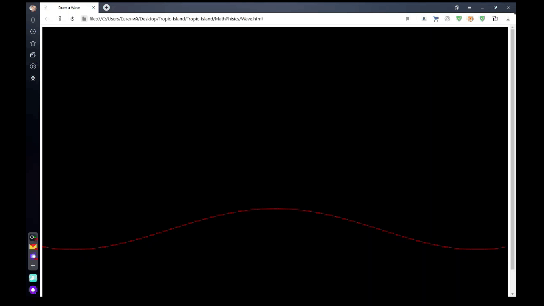Bonne journée!
Aujourd'hui, je voudrais vous présenter un petit programme qui utilise la formule d'Alembert:

À mon avis, il y a ici un décalage de la fonction de l'un par rapport à l'autre, à cause duquel une onde se forme. Les arguments de la fonction sont x et t, vous pouvez également utiliser l'accélération a. Deux fonctions fi et ksi, plus précisément y (au lieu de ksi).

Le programme est écrit à l'aide d'un navigateur et WebGL.
Fichier Wave.html:
<!DOCTYPE html>
<html lang="en">
<head>
<meta charset="utf-8" />
<title>Draw a Wave</title>
</head>
<body onload="main()">
<canvas id="webgl" width="1600" height="1000">
Please use a browser that supports "canvas"
</canvas>
<script src="webgl-utils.js"></script>
<script src="webgl-debug.js"></script>
<script src="cuon-utils.js"></script>
<script src="Wave.js"></script>
</body>
</html>
Vous devez mettre webgl-utils.js webgl-debug.js cuon-utils.js dans le fichier Wave.html ou les trouver sur le net et vous connecter.

Fichier Wave.js:
// Vertex shader program
var VSHADER_SOURCE =
'attribute vec4 a_Position;\n' +
'void main() {\n' +
' gl_Position = a_Position;\n' +
'}\n';
// Fragment shader program
var FSHADER_SOURCE =
'void main() {\n' +
' gl_FragColor = vec4(1.0, 0.0, 0.0, 1.0);\n' +
'}\n';
var xx=0;
function main() {
// Retrieve <canvas> element
var canvas = document.getElementById('webgl');
// Get the rendering context for WebGL
var gl = getWebGLContext(canvas);
if (!gl) {
console.log('Failed to get the rendering context for WebGL');
return;
}
// Initialize shaders
if (!initShaders(gl, VSHADER_SOURCE, FSHADER_SOURCE)) {
console.log('Failed to intialize shaders.');
return;
}
// Write the positions of vertices to a vertex shader
var n = initVertexBuffers(gl);
if (n < 0) {
console.log('Failed to set the positions of the vertices');
return;
}
// Specify the color for clearing <canvas>
gl.clearColor(0, 0, 0, 1);
var tick = function() {
draw(gl, n); // Draw function
requestAnimationFrame(tick, canvas); // Request that the browser calls tick
};
tick();
}
function draw(gl, n) {
// Clear <canvas>
gl.clear(gl.COLOR_BUFFER_BIT);
initVertexBuffers(gl);
// function
gl.drawArrays(gl.LINE_STRIP, 0, n);
}
function fi(x)
{
return Math.cos(x);
}
function ksi(x)
{
return Math.sin(3*x);
}
function Dalamber(x,t)
{
return 0.5*(fi(x-t) + fi(x+t))+0.5*(ksi(x+t)-ksi(x-t));
}
function initVertexBuffers(gl) {
var vertices = new Float32Array(400);
var i=0;
for(var t=-1.0;t<1.0;t+=0.01)
{
vertices[i]=t;
vertices[i+1]=Dalamber(t,xx)/2;
//document.write("x=",vertices[i],"y=",vertices[i+1]+"<br>");
i+=2;
}
xx+=0.01;
var n = vertices.length/2;
// Create a buffer object
var vertexBuffer = gl.createBuffer();
if (!vertexBuffer) {
console.log('Failed to create the buffer object');
return -1;
}
// Bind the buffer object to target
gl.bindBuffer(gl.ARRAY_BUFFER, vertexBuffer);
// Write date into the buffer object
gl.bufferData(gl.ARRAY_BUFFER, vertices, gl.STATIC_DRAW);
var a_Position = gl.getAttribLocation(gl.program, 'a_Position');
if (a_Position < 0) {
console.log('Failed to get the storage location of a_Position');
return -1;
}
// Assign the buffer object to a_Position variable
gl.vertexAttribPointer(a_Position, 2, gl.FLOAT, false, 0, 0);
// Enable the assignment to a_Position variable
gl.enableVertexAttribArray(a_Position);
return n;
}
Vous pouvez expérimenter les fonctions fi et ksi, modifier les paramètres et ajouter d'autres fonctions, les additionner, les multiplier.

Résultat:

Ne jugez pas strictement et merci de votre attention!
PS Si vous comprenez mon karma au moins à 0, je posterai autre chose d'intéressant.